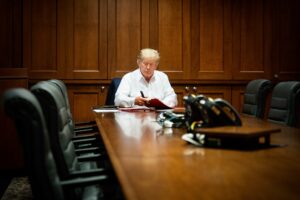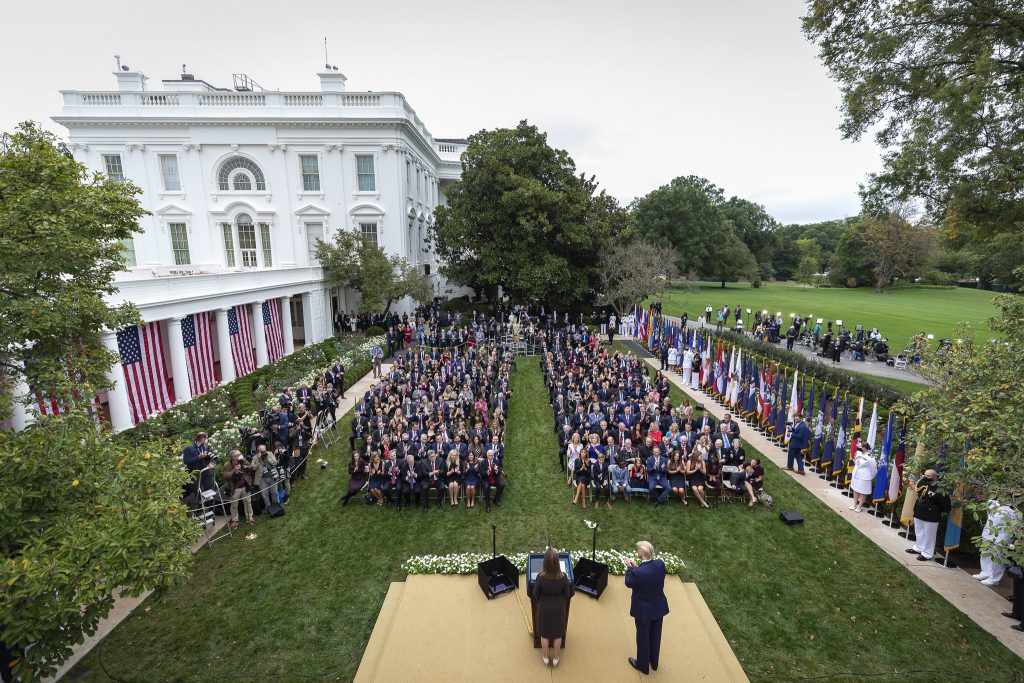The president’s minimization of Covid-19 led to the complacency which caught him the virus

Perhaps the greatest surprise of Trump’s infection was that it took him over eight months since the first U.S. case of Covid-19 to contract the virus.
He spent these months minimizing the pandemic, unrelenting even when it arrived at American shores. “We have it totally under control. It’s just one person coming in from China,” he said in an interview with CNBC. “It’s going to be just fine.”
Seven more U.S. cases and a travel ban later, “We pretty much shut it down coming in from China,” he said when interviewed by Sean Hannity.
“We can and should be prepared for this new virus to gain a foothold in America,” Dr. Nancy Mesonnier of the CDC warned in February.
“When you have fifteen [cases], and the fifteen within a couple of days is going to be down to close to zero, that’s a pretty good job we’ve done,” Trump said less than two weeks later.
Trump’s optimism regarding Covid-19 despite the warnings of countless experts has been a threat from the start, one which was only exacerbated by the politicization of the virus. “This is [the Democrats’] new hoax,” Trump proclaimed at a February 28 campaign rally in South Carolina. And with that, he maneuvered himself into a position in which his contrarian politics demanded that he attack the legitimacy of the “hoax”; he could not acknowledge the severity of the virus without ceding defeat.
As evidenced by numerous interviews, speeches, and tweets throughout his presidency, Trump is a man who cares deeply about the projection of strength. However, while bombast is by no means new to the political arena, the devastation it has wreaked on the U.S. over the course of this pandemic is significant. The recently published book Rage by Bob Woodward, Washington Post associate editor and Watergate scandal investigative reporter, details the Trump administration’s response to the early stages of pandemic, revealing that as early as February, Trump acknowledged that “[t]his is deadly stuff.” And yet, “I think it’s all going to work out fine,” he assured the public three days later at a rally in New Hampshire.
“I wanted to play it down,” Trump said in March in an interview with Woodward. “I still like playing it down, because I don’t want to create a panic.” Even so, as complacency led to disregard for masking and social distancing, one might argue that some panic would have been beneficial. Rather, what Trump has revealed of his temperament and principles over the last four years is that public opinion is of such importance to him that he would deny the imminent threat of a pandemic that has reached his shores if it meant preserving the facade of control—which is precisely what he has done. “The Coronavirus is very much under control in the USA,” he tweeted in February.
Predictably, the consequences for this have been dire. The way Trump dragged his feet in his personal response to the virus—only beginning to wear a mask as late as July and continuing to hold massive campaign rallies despite experts cautioning against large gatherings—left him vulnerable. Furthermore, as is to be expected with such a leader, this dismissiveness of the pandemic’s severity was endemic in the White House. Despite the use of rapid testing that was known to fail in detecting infections where concentrations of the virus were below a certain threshold, those who tested “negative” went about without masks, and often convened in close quarters, indoors.
On September 26, the White House hosted its own super-spreader event in the Rose Garden, where two hundred guests gathered–unmasked and closely packed—for the announcement of Judge Amy Coney Barrett’s Supreme Court nomination. This followed an indoor reception with at least 100 guests, who were also unmasked and closely packed, and were photographed making physical contact nonetheless. Though the White House refuses to undertake comprehensive contact tracing, the timeline of the development of Covid-19 symptoms suggest that at least eight people contracted the virus at this event—including Trump.

Trump’s infection was the culmination of months of dissembling the threat of the virus to propagate an illusion of control. His obsession with this illusion and his contrarian approach to policy are not new; they have been common themes throughout his presidency. In Rage, former White House Staff Secretary Rob Porter was quoted saying, regarding Trump’s decisions on foreign policy, “This was no longer a presidency. This is no longer a White House. This is a man being who he is.” This has been true, too, regarding his response to the pandemic. Speaking about the catastrophic death toll in the U.S., former Vice President Joe Biden articulated this in the first presidential debate: “It is what it is because you are what you are.”
Indeed, “I had no choice,” Trump said about the irresponsibility of his conduct, in a video statement released after his infection. He was incapable of defying his nature; he simply continued the patterns of behavior that he has practiced for years. Even now, having apparently recovered from his infection, Trump continues in his attempt to maintain his illusion, tweeting, “Feeling really good! Don’t be afraid of Covid. Don’t let it dominate your life.” But it remains that this illusion facilitated complacency and inadequate precautions that made the White House outbreak which infected him inevitable.